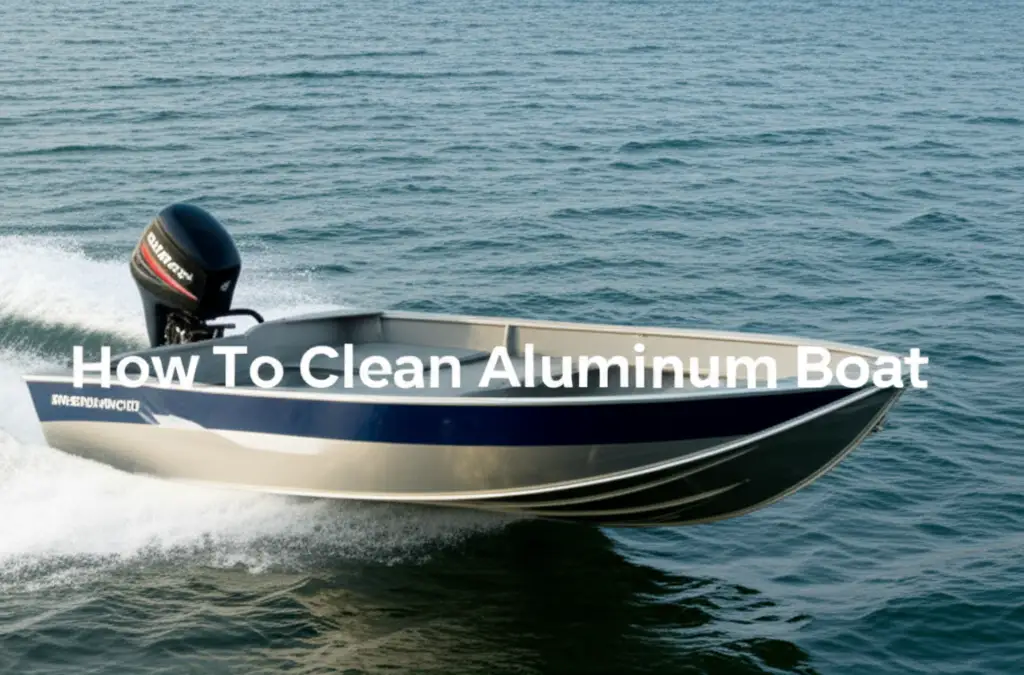· Boat Maintenance · 18 min read
How To Clean Plastic Windows On A Boat

Clean Plastic Windows on a Boat: A Comprehensive Guide
Boating brings immense joy, but a clear view makes all the difference. Your boat’s plastic windows, often made of vinyl, acrylic, or polycarbonate, offer protection from elements. These windows can become cloudy, scratched, or hazy over time due to sun exposure, saltwater, and environmental pollutants. A clear view is not just about aesthetics; it is about safety. Impaired visibility creates dangerous situations on the water. Therefore, knowing how to properly clean plastic windows on a boat is essential for every boat owner.
I understand the frustration of looking through cloudy boat windows. This article helps you restore clarity to your boat’s plastic windows. We explore various types of plastic windows, essential cleaning tools, and a step-by-step cleaning process. You will also learn how to tackle stubborn issues like oxidation and how to prevent future damage. Maintaining clear windows extends their lifespan and enhances your boating experience.
Takeaway:
- Use proper cleaning techniques and gentle products to avoid scratching plastic boat windows.
- Rinse thoroughly to remove loose dirt before washing.
- Apply specialized cleaners for oxidation and hazing.
- Protect windows with UV-blocking polishes or coatings.
- Regular maintenance prevents significant damage and maintains clarity.
To properly clean plastic windows on a boat, use only specialized plastic window cleaners or mild, pH-neutral soap with soft microfiber cloths. Always rinse the windows thoroughly with fresh water first to remove loose dirt, then gently wash, rinse again, and dry with a clean, lint-free towel to prevent scratches and streaks.
Understanding Your Boat’s Plastic Windows
Knowing the type of plastic your boat windows use helps you choose the right cleaning method. Most boat windows are not glass; they are a form of plastic. Each material has unique properties that affect how you clean it. Misinformation can lead to irreversible damage.
Marine plastics offer flexibility and impact resistance, but they scratch easier than glass. They also degrade under UV light and harsh chemicals. Understanding these characteristics helps you maintain their clarity and extend their life. I have seen many boat owners ruin their windows by using the wrong products.
Types of Plastic Windows
Boats typically feature three main types of clear plastic for windows and enclosures. Each type offers different benefits and requires specific care. Knowing your window type is the first step in effective cleaning.
- Clear Vinyl (Strataglass, EZ2CY): This material is flexible and common in boat enclosures. It is prone to scratching and hazing if not cleaned correctly. UV inhibitors are often added, but sun exposure still causes degradation. I have found this material to be the most delicate.
- Acrylic (Plexiglass, Perspex): Acrylic is a rigid plastic known for its clarity and resistance to yellowing. It is more scratch-resistant than vinyl but still susceptible to damage from abrasive cleaners. It cracks under stress or impact.
- Polycarbonate (Lexan): Polycarbonate is extremely impact-resistant, making it popular for windows that need high durability. It is often coated to improve scratch resistance, but uncoated polycarbonate scratches easily. It can yellow over time.
Common Issues with Marine Plastics
Marine plastic windows face several challenges due to the harsh marine environment. These issues reduce visibility and degrade the window’s appearance. Identifying the problem helps you select the correct solution.
- Scratches: These are the most common issue. Sand, salt, and improper wiping create fine lines or deep grooves. Scratches scatter light and reduce clarity.
- Hazing and Cloudiness: UV radiation, oxidation, and chemical exposure cause the plastic to become cloudy. The surface appears dull and opaque. This is often an early sign of degradation.
- Yellowing: Prolonged sun exposure can cause plastic to turn yellow. This indicates significant UV damage and is often difficult to reverse completely.
- Water Spots: Hard water or dried saltwater leaves mineral deposits on the surface. These spots are unsightly and can etch into the plastic if left untreated.
- Salt Build-up: Salt spray dries on the windows, leaving a crystalline film. This film can be abrasive if not rinsed off before cleaning. I always rinse my windows thoroughly after a day on the water.
Essential Tools and Cleaning Products
Selecting the right tools and cleaning agents is crucial for effective and damage-free cleaning. Using abrasive materials or harsh chemicals causes permanent damage. Always prioritize products designed for plastic windows. I cannot stress enough the importance of gentle materials.
You need a collection of soft cloths, clean water, and specific cleaning solutions. Avoid household glass cleaners, paper towels, or brushes. These items often contain ammonia or alcohol, which harm plastic, or they are too rough. Your goal is to lift dirt without scratching or degrading the surface.
Recommended Cleaning Solutions
Specialized cleaners exist for marine plastic windows. These solutions are formulated to be gentle yet effective. They clean without stripping protective coatings or causing hazing.
- Specialized Plastic Cleaners: Many marine brands offer specific plastic window cleaners. These are safe and effective. They often contain polymers that fill micro-scratches and leave a protective layer. Always read the product label for specific instructions.
- Mild, pH-Neutral Soap: For general cleaning, a very mild, pH-neutral soap mixed with fresh water works well. Dish soap is often too strong. Baby shampoo or a dedicated boat soap are better choices. Dilute the soap heavily to create a gentle solution.
- Water-Based Cleaners: Look for cleaners that are water-based and free of ammonia, alcohol, and harsh solvents. These chemicals can dry out and crack plastic over time. They also break down UV inhibitors.
- Vinegar and Water (for water spots): A diluted white vinegar solution can help remove stubborn water spots. Mix equal parts white vinegar and distilled water. Test it on an inconspicuous area first. This method works well for mineral deposits. You can learn more about general cleaning with vinegar and baking soda methods here.
What to Avoid
Certain products and materials are detrimental to plastic windows. Using them can lead to irreparable damage, reducing clarity and lifespan. Understanding what to avoid is just as important as knowing what to use.
- Abrasive Materials: Never use paper towels, rough sponges, or abrasive cloths. These materials scratch plastic surfaces easily. Always use soft, clean microfiber cloths or natural sponges.
- Ammonia-Based Cleaners: Products like Windex contain ammonia, which breaks down plastic. It causes hazing, cracking, and yellowing over time. Avoid anything labeled for “glass” unless it specifically states “safe for plastic.”
- Alcohol-Based Cleaners: Alcohol can dry out plastic, leading to brittleness and cracking. It also strips away any protective coatings. Check ingredient lists carefully.
- Harsh Solvents: Acetone, paint thinner, and other strong solvents dissolve or severely damage plastic. Keep these far away from your boat windows.
- Dry Wiping: Never wipe dry plastic windows. Always pre-rinse them to remove loose dirt and grit. Dry wiping grinds these particles into the plastic, causing scratches. I always wet the surface first.
Step-by-Step Guide to Cleaning Plastic Windows
A systematic approach ensures thorough cleaning without damage. Follow these steps for crystal-clear boat windows. Patience and gentle movements are key. Rushing the process can lead to new scratches.
This process applies to routine cleaning. Stubborn stains or hazing may require additional steps. However, a good basic cleaning routine prevents most issues. I follow these steps every time I clean my boat.
Initial Rinse and Dust Removal
Before touching the windows with any cloth, remove all loose dirt, salt, and debris. This step prevents scratching the delicate plastic surface. Dirt acts like sandpaper when rubbed against the window.
- Use Fresh Water: Hose down the plastic windows with a gentle stream of fresh water. Start from the top and work your way down. Ensure the water pressure is not too high.
- Flush Away Debris: Allow the water to run over the entire surface for a minute or two. This helps dislodge salt crystals, dust, and other loose particles. Direct the water flow to push debris off the window, not just spread it around.
- No Contact Yet: Resist the urge to wipe or scrub at this stage. Any contact before rinsing can cause scratches. Ensure the surface is thoroughly wet and free of visible grit.
Gentle Washing Technique
Once the surface is free of loose debris, it is time to gently wash the windows. This step removes grime, streaks, and light buildup. The key is using minimal pressure and the right tools.
- Prepare Cleaning Solution: Mix your chosen mild, pH-neutral soap (e.g., specific boat soap or baby shampoo) with fresh water in a bucket. Use a clean, soft microfiber cloth or sponge. The solution should be foamy but not overly sudsy.
- Wash in Small Sections: Dip your microfiber cloth into the solution. Gently wipe the window in small, overlapping sections. Use very light pressure. Move the cloth in straight lines or a circular motion, depending on the manufacturer’s recommendation for your specific window type. For many plastic windows, straight, horizontal strokes are preferred to minimize visible swirl marks if any occur.
- Rinse Cloth Often: Rinse your cloth frequently in clean water to prevent transferring dirt back onto the window. Use multiple cloths if necessary to ensure you are always using a clean surface.
- Rinse Thoroughly: After washing a section, immediately rinse it with fresh water. This prevents the soap from drying on the surface and leaving streaks or residue. Ensure all soap residue is completely removed. Preventing streaks is important for any clear surface, similar to how you would clean a glass stove top without streaks.
Drying for Streak-Free Results
Drying is a critical step to achieve a clear, streak-free finish. Air drying often leads to water spots, especially with hard water. Proper drying techniques ensure pristine clarity.
- Use a Dedicated Drying Cloth: Use a separate, clean, dry, lint-free microfiber cloth for drying. Keep this cloth distinct from your washing cloths. Ensure it has not been used with any other cleaning agents.
- Blot or Lightly Wipe: Gently blot the water off the surface or wipe it lightly in one direction. Avoid rubbing vigorously. Rubbing can create static and attract dust, or even cause micro-scratches on still-damp surfaces.
- Work Quickly: Dry the windows relatively quickly after rinsing to prevent water spots from forming. If working on a large area, dry sections as you finish washing and rinsing them.
- Consider a Blower: For large surfaces, a leaf blower on a low, cool setting can gently blow away water droplets without contact, reducing the chance of streaks. Ensure the blower is clean and free of debris.
Removing Stubborn Stains and Haze
Routine cleaning addresses daily grime, but older, neglected plastic windows may suffer from oxidation or deep water spots. These issues require more targeted treatments. Do not expect miracles with a simple wash. Specialized products are often necessary.
I have found that patience is key when dealing with these tough problems. Aggressive scrubbing makes the problem worse. Always test any new product on an inconspicuous area first.
Tackling Oxidation
Oxidation makes plastic windows appear cloudy, hazy, or yellowish. It is caused by UV exposure breaking down the plastic’s surface. Removing oxidation restores much of the window’s clarity.
- Identify the Extent: Mild oxidation might appear as a slight haze. Severe oxidation causes a significant lack of transparency. The approach depends on the severity.
- Use a Plastic Polish/Restorer: For mild to moderate oxidation, use a dedicated plastic polish or restorer. These products contain fine abrasives that gently remove the degraded outer layer of plastic. Apply a small amount to a soft microfiber applicator pad.
- Work in Small Areas: Rub the polish onto the window using gentle, circular motions. Work on small sections at a time. The polish will start to haze as it dries; this is normal.
- Buff Off: Use a clean, dry microfiber cloth to buff off the dried polish. You will notice the clarity improving as you buff. Repeat the process if necessary for heavily oxidized areas. This process is somewhat similar in principle to how you might tackle stubborn deposits on a burnt glass stove top, though the materials and specific products differ.
- Follow with Protector: After restoring clarity, apply a plastic protector or sealant. This helps to slow down future oxidation and UV damage.
Addressing Water Spots
Water spots, especially from hard water or dried saltwater, can etch into the plastic surface. Regular cleaning often does not remove them entirely. You need an acidic solution to dissolve mineral deposits.
- Vinegar Solution: Mix equal parts white vinegar and distilled water in a spray bottle. Vinegar is mildly acidic and helps dissolve mineral deposits. Distilled water prevents new spots.
- Apply and Dwell: Spray the vinegar solution onto the affected areas. Let it sit for a few minutes to allow the acid to break down the minerals. Do not let it dry on the surface.
- Gentle Scrub: Use a clean, soft microfiber cloth to gently wipe and agitate the water spots. You may need to apply a little more pressure than routine cleaning, but still avoid harsh scrubbing.
- Rinse Thoroughly: After removing the spots, rinse the window immediately and thoroughly with fresh water. This removes all vinegar residue.
- Dry Immediately: Dry the window with a clean, lint-free microfiber cloth to prevent new water spots from forming.
- Repeat if Necessary: For very stubborn spots, you may need to repeat the process. Avoid leaving the vinegar solution on for extended periods.
Preventing Scratches and Future Damage
Prevention is always easier than repair. Protecting your boat’s plastic windows from scratches and environmental damage extends their life and maintains clarity. Small preventative steps yield big results.
I always preach proactive care for marine plastics. Once a scratch is deep, it is hard to remove completely. Investing in good habits and protective products saves money and effort in the long run.
Proper Maintenance Habits
Daily habits significantly impact the condition of your plastic windows. Simple changes in how you handle and clean them make a huge difference. These habits become second nature over time.
- Rinse Before Cleaning: Always, always rinse your windows with fresh water before any wiping or cleaning. This removes abrasive particles that cause scratches. This is the single most important rule for preventing scratches.
- Use Soft Materials Only: Use only dedicated soft microfiber cloths, lambswool mitts, or very soft sponges. Avoid anything abrasive, including paper towels or old rags.
- Wash Gently: Apply minimal pressure when washing or wiping. Let the cleaning solution and the soft cloth do the work. Excessive force increases the risk of scratching.
- Work in Shade: Clean windows in the shade or on a cool, overcast day. Cleaning in direct sunlight causes cleaners to dry too quickly, leading to streaks and potential damage.
- Regular Cleaning: Clean your windows regularly, especially after saltwater exposure. Frequent light cleaning prevents dirt and salt buildup that requires more aggressive, damaging methods later.
Applying Protective Coatings
Once clean, applying a protective coating offers an extra layer of defense against UV rays, scratches, and environmental contaminants. These coatings also make future cleaning easier.
- UV Protectants: Many marine plastic cleaners and polishes contain UV inhibitors. These block harmful UV rays, preventing yellowing and oxidation. Apply these products as directed by the manufacturer, usually every few months.
- Polymer Sealants: Specialized polymer sealants create a slick, protective barrier on the plastic surface. This barrier repels water, dirt, and salt, making cleanup simpler. It also reduces static cling, which attracts dust.
- Scratch Fillers/Polishes: While not truly “preventative,” some polishes contain mild abrasives and fillers that can reduce the appearance of minor scratches. They do not prevent new scratches but help maintain clarity. Using these regularly as part of your maintenance routine helps keep the surface smooth. Think of it like managing minor imperfections, somewhat akin to addressing scratches on a black glass stove top, but with specific products for plastic.
- Ceramic Coatings (Specialized): Some advanced ceramic coatings are now available for marine plastics. These offer long-lasting protection and incredible slickness, making surfaces very easy to clean. They require professional application or careful DIY application. These are a significant investment but offer superior protection.
- Frequency of Application: Follow the manufacturer’s instructions for reapplication. Generally, UV protectants and sealants should be reapplied every 3-6 months, depending on exposure.
Long-Term Care for Optimal Clarity
Maintaining optimal clarity for your boat’s plastic windows goes beyond just cleaning. It involves consistent long-term care and protection. A little effort consistently makes a big difference. This section focuses on habits and strategies that keep your windows looking new for years.
Neglecting your boat windows means facing expensive replacements down the line. Proper care extends their lifespan significantly. I have seen boats with 20-year-old windows that still look great because of consistent care.
Regular Cleaning Schedule
Consistency is key to preventing buildup and maintaining clarity. Establishing a regular cleaning schedule makes the task less daunting and prevents major issues. Small, frequent efforts are better than infrequent, intense cleaning.
- After Every Use: If your boat is used frequently, a quick rinse with fresh water after every outing is ideal. This washes away saltwater and loose dirt before they can dry and cause problems.
- Weekly/Bi-Weekly Washing: For boats in frequent use or exposed to high salt spray, a full gentle wash (as described in the step-by-step guide) every week or two is recommended. This prevents the accumulation of grime and salt.
- Monthly Polishing/Protection: Apply a plastic polish with UV inhibitors or a dedicated plastic sealant monthly or bi-monthly. This restores minor clarity issues and provides a protective layer against sun damage and scratching. Adjust frequency based on sun exposure and product longevity.
- Seasonal Deep Clean: At the beginning and end of the boating season, perform a deep clean. This includes addressing any accumulated oxidation, persistent water spots, or minor scratches. This is also a good time to reapply any long-lasting protective coatings.
- Inspect Regularly: During each cleaning, inspect your windows for any new scratches, hazing, or signs of wear. Early detection allows for easier remediation.
Storage and Protection Tips
How you store your boat and protect its windows when not in use significantly impacts their condition. Environmental factors, especially UV radiation, are major culprits in plastic degradation.
- Use a Boat Cover: When the boat is stored, especially outdoors, use a high-quality boat cover. Ensure the cover does not rub against the plastic windows, which can cause chafing or scratches. Look for covers with soft linings or those designed to tent over windows.
- Enclosure Curtains: If your boat has full enclosures, consider rolling them up carefully or using dedicated storage bags. Do not fold clear vinyl windows tightly, as this can cause creases and cracks. Roll them gently, ensuring no dirt is trapped inside the rolls.
- Shade Parking: Whenever possible, park your boat in the shade or under a covered slip. Reducing direct UV exposure is the best defense against yellowing and oxidation.
- Ventilation: Ensure adequate ventilation when covering your boat. Trapped moisture can lead to mold or mildew growth, which can stain windows.
- Avoid Harsh Elements: Try to avoid exposing your boat windows to extreme heat, cold, or prolonged direct sun when not in use. If storing for winter, ensure windows are clean and protected with a sealant.
- Educate Users: Inform anyone who handles your boat or its cover about the proper care of the plastic windows. A single careless act can undo months of diligent maintenance.
FAQ Section
How often should I clean my boat’s plastic windows?
You should rinse your plastic boat windows with fresh water after every use, especially in saltwater. A full wash with mild soap and water is recommended weekly or bi-weekly. Apply a protective polish or sealant monthly or every few months depending on sun exposure. Consistent, gentle cleaning prevents major issues.
Can I use household glass cleaner on plastic boat windows?
No, you should never use household glass cleaners, such as Windex, on plastic boat windows. Most household glass cleaners contain ammonia or alcohol. These chemicals can dry out plastic, causing hazing, cloudiness, cracking, and yellowing over time. Always use cleaners specifically formulated for marine plastics.
How do I remove deep scratches from plastic boat windows?
Removing deep scratches from plastic boat windows is challenging and often requires professional help or specialized kits. For minor scratches, a plastic scratch remover or polish with very fine abrasives can gently buff them out. Always test on a small, hidden area first and follow product instructions carefully.
What causes plastic boat windows to turn yellow or hazy?
Plastic boat windows typically turn yellow or hazy due to prolonged exposure to ultraviolet (UV) radiation from the sun. This causes the plastic to break down through a process called oxidation. Environmental pollutants, harsh cleaning chemicals, and lack of protective coatings also contribute to degradation and hazing over time.
Is it better to roll up or fold clear vinyl boat windows for storage?
It is always better to roll up clear vinyl boat windows rather than folding them. Folding creates sharp creases and stress points that can lead to permanent cracks and damage, especially in colder temperatures. Rolling them gently prevents creasing and helps maintain their original shape and clarity during storage.
What is the best way to prevent water spots on boat windows?
To prevent water spots on boat windows, always rinse them thoroughly with fresh, clean water immediately after washing. Then, dry the windows quickly and completely using a clean, soft, lint-free microfiber cloth. Applying a polymer sealant or wax can also help water bead up and roll off, reducing spot formation.
Conclusion
Keeping your boat’s plastic windows clear is vital for both safety and enjoyment. We have covered the different types of plastic windows, the right tools, and a detailed cleaning process. Remember to rinse first, wash gently with appropriate products, and dry thoroughly to prevent streaks and scratches. Addressing stubborn issues like oxidation and water spots requires specific solutions, but consistent effort yields great results.
Preventing future damage through proper maintenance habits and protective coatings extends the life of your windows. Regular cleaning and mindful storage practices help maintain clarity for years. By following these steps, you will enjoy a clear view of the water and keep your boat looking its best. Invest time in cleaning plastic windows on a boat correctly, and your efforts will be rewarded with years of clear sailing. Your boat, and your eyes, will thank you.
- boat window cleaning
- plastic windows
- marine care
- scratch prevention
- window maintenance
- boat cleaning tips




